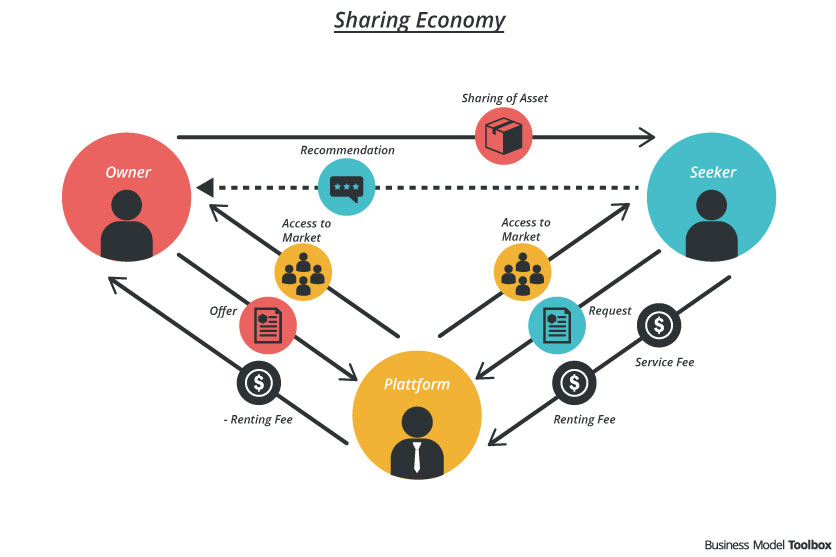
“Uber App” by focal5 is licensed under CC BY-NC 2.0.
INTRODUCTION
The sharing economy has been a very popular term in recent years, but now some scholars believe that the sharing economy has been redefined. And the one who redefines it is now one of the leaders of the sharing economy platform even becoming one of the synonyms for the sharing economy, Uber. Uber was co founded in 2009 by University of California, Los Angeles dropout Travis Kalanick and friend Garrett Camp. Due to its eponymous taxi app, it has gained a great reputation. The main function of this app is to connect passengers and drivers, providing shared economy services such as passenger vehicle rental and carpooling (Lauren Good, 2011). Passengers can book these passenger carrying vehicles through the application and track their location. It is precisely because of this app that Uber began its development history with mixed reviews.
A heroic start

“Sharing Economy” byBusiness Model Toolboxis licensed under CC BY 4.0.
The earliest sharing economy was used for production, incentivizing employees to improve production efficiency by sharing company profits (John, 2016). With the concept of sharing economy once again being utilized by these sharing economy platforms led by Uber, the sharing economy has become a system for individuals and businesses to share or rent resources through online platforms.
Taking Uber’s taxi application as an example, its innovation has overturned people’s understanding of traditional taxis. Uber will connect drivers who provide ride services with passengers who search for rides online.(Georgios Petropoulos,2016) Potential passengers only need to download an app on their mobile device to find nearby Uber cars, and the cost is usually lower than traditional taxis, which makes more and more passengers more willing to use the platform for taxis. In terms of drivers, Uber lowered the threshold for becoming a driver. Becoming a Uber driver does not require the purchase of a license to enter the market, as in the traditional taxi industry. Instead, it meets the definition of a sharing economy. Simply put, as long as you have a driver’s license and your own car, you can drive your own car to the app in your free time to pick up orders. This is also a disruptive reform for the traditional taxi industry.
With the continuous development and innovation of Uber in the traditional taxi industry. Based on the new concept of sharing economy, Uber has proposed carpooling services. In August 2014 alone, there were nearly one billion carpool trips worldwide. From this, it can be seen that its pioneering work has received widespread attention and recognition from users worldwide. According to statistics, the number of users of Uber apps has been growing rapidly from 2017 to 2019. It can be seen that as time goes by, more and more people are beginning to realize the convenience that the sharing economy brings to people’s lives and are willing to join it. It can be said that Uber has changed the traditional taxi industry and even changed people’s way of travel. Its emergence has made travel more convenient and efficient, while also providing many employment or part-time positions. The emergence of carpooling has also effectively alleviated traffic congestion in various cities and even played a protective role in the environment.
The Criminals of Sharing Economy
With the development and growth of Uber, some skeptical voices have also emerged, believing that the sharing economy is “an unregulated and exploitative system”(John, 2016). The main reason is that negative news about Uber has been common online recently. Drivers such as Uber and Lyft condemn low wages and unfair shutdowns, as well as Uber violating the law, deceiving the police, and secretly lobbying the government. These news have caused Uber’s position in people’s hearts to plummet. As one of the top platforms in the sharing economy, people’s attitude towards Uber has directly influenced their impression of the sharing economy. The above two news mercilessly tore apart Uber’s “heroic start”. The lie of Uber widely promoting how to improve the lives of its “driver partners” (Lawrence Mishel, 2018) in order to recruit more drivers to work for it has been exposed. The reality is that its driver’s hourly salary is only $9-11, lower than the hourly salary of traditional taxi drivers. Simply put, most of Uber’s profits are earned by squeezing the driver’s salary. This is why some people believe that the sharing economy is “a system of exploitation”. The reason why the sharing economy is “an unregulated system” is reflected in two aspects. In terms of the taxi industry, Uber wants to transform the traditional taxi industry into a completely private and investor supported industry, completely detached from government regulation, through its own reforms. On the other hand, as more and more of Uber’s actual backend data is exposed, Uber uses persuasion or bribing some politicians and media to promote it as a technology company, in order to evade any regulatory scrutiny of its actual economic situation. Under the pen of the media, Uber has even created a role in which it is fighting for progress and economic freedom, opposing regulation.
The current sharing economy is completely an exploitative and unregulated system. “The private wealth it creates is entirely at the cost of sacrificing other people in society”(Hubert Horan, 2019). At the same time, using legal or regulatory loopholes to evade any regulatory scrutiny of the actual economic situation of the sharing economy by regulatory authorities has even become a tool for some capitalists to transform some public industries into private ones. This reflects some issues with the sharing economy. There is a lack of comprehensive laws to maintain the relationship between users and platforms, and there is a lack of real-time supervision and regulatory efforts for sharing economy platforms.
How to do in the future
Based on the analysis of the sharing economy above, it is not difficult to see some issues that arise in the sharing economy, such as whether the sharing economy platform is a technology company or a company in the relevant industry, and whether uber is a technology company or a taxi company. Can technology companies escape regulatory oversight. The most important way to solve these problems is to restrict the sharing economy platform through regulatory agencies and legal institutions to ensure the interests of users by issuing corresponding laws. But with the popularity of the sharing economy, there are no complete and supporting laws proposed, which has led to the sharing economy becoming a tool for some capitalists to exploit ordinary people or drivers. At the same time, some government regulatory departments also need to strengthen their supervision of the sharing economy platform. Avoid sharing economy platforms that evade economic regulation under the guise of technology companies.
CONCLUSION
Source: Is Driving For Uber Still Worth It? (PROS & CONS) – YouTube
In summary, Uber, as one of the leading platforms in the sharing economy, showcases the advantages of the sharing economy. Its innovation has made people’s lives more convenient and changed their way of travel. At the same time, it also provides a large number of employment or part-time positions. The good use of these advantages can even help cities reduce road congestion and protect the environment. But its drawbacks are also obvious. Through the above video, we can more intuitively experience the changes that the sharing economy has brought to their lives from the perspective of Uber drivers. With the gradual popularization of the sharing economy and the absence of relevant laws and regulations, the sharing economy has gradually become a tool for some capitalists to satisfy their own interests by squeezing the people. Drivers are the most exploited group among them. As one of the users of the sharing economy platform, although they can find jobs and earn money through the sharing economy platform, they need to work harder than the traditional taxi industry to earn salaries similar to the traditional taxi industry. Ironically, most of the drivers’ profits ultimately enter the profits of the sharing economy platform. From this, it can be seen that the sharing economy still requires relevant government departments to restrict sharing economy platforms and protect user rights through laws and stricter regulations.
References:
ProQuest (Firm) (Ed.). (2016). Sharing Economies. In John, The age of sharing (pp. lviii–lxxvii). Polity.
Hubert Horan. (2019). Uber’s Path of Destruction.
Lawrence Mishel. (2018). Uber and the Labor Market: Uber Drivers’ Compensation, Wages, and the Scale of Uber and the Gig Economy
Georgios Petropoulos. (2016). Uber and the economic impact of sharing economy platforms
https://www.bruegel.org/blog-post/uber-and-economic-impact-sharing-economy-platforms
Lauren Goode. (2011). Worth It? An App to Get a Cab.
https://www.wsj.com/articles/BL-DGB-22634
Michael Sainato. (2023). ‘It was traumatic’: Uber, Lyft drivers decry low pay and unfair deactivations, at https://www.theguardian.com/business/2023/mar/10/uber-lyft-driver-suspension-deactivation-pay accessed 10 Mar 2023
The Uber File. (2022). Uber broke laws, duped police and secretly lobbied governments, leak reveals https://www.theguardian.com/news/2022/jul/10/uber-files-leak-reveals-global-lobbying-campaign accessed 12 Jul 2023
Statista Research Department. (2023). Monthly number of Uber’s active users worldwide from 2017 to 2023, by quarter (in millions). https://www.statista.com/statistics/833743/us-users-ride-sharing-services/ accessed 12 May 2023
Uber Australia. (2018). Introducing uberPOOL: A New Way to Share.
https://www.uber.com/en-AU/newsroom/uberpoolau/#:~:text=Since%20we%20launched%20uberPOOL%20in%20other%20global%20markets,Uber%20trips%20in%20the%20cities%20where%20it%E2%80%99s%20available. accessed 28 Mar 2018
The Rideshare Hub. (2022). Is Driving For Uber Still Worth It? (PROS & CONS). https://www.youtube.com/watch?v=FasbJiq11Fk&t=174s licensed under CC BY 4.0.

